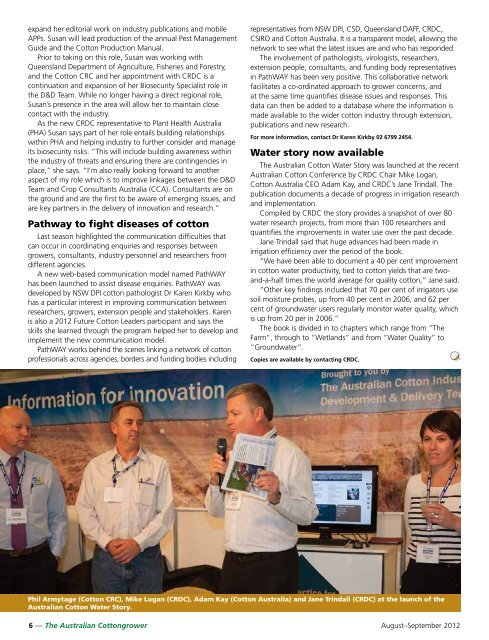growers@sgcotton.com.au Roger Tomkins - Greenmount Press
growers@sgcotton.com.au Roger Tomkins - Greenmount Press
growers@sgcotton.com.au Roger Tomkins - Greenmount Press
Create successful ePaper yourself
Turn your PDF publications into a flip-book with our unique Google optimized e-Paper software.
expand her editorial work on industry publications and mobile<br />
APPs. Susan will lead production of the annual Pest Management<br />
Guide and the Cotton Production Manual.<br />
Prior to taking on this role, Susan was working with<br />
Queensland Department of Agriculture, Fisheries and Forestry,<br />
and the Cotton CRC and her appointment with CRDC is a<br />
continuation and expansion of her Biosecurity Specialist role in<br />
the D&D Team. While no longer having a direct regional role,<br />
Susan’s presence in the area will allow her to maintain close<br />
contact with the industry.<br />
As the new CRDC representative to Plant Health Australia<br />
(PHA) Susan says part of her role entails building relationships<br />
within PHA and helping industry to further consider and manage<br />
its biosecurity risks. “This will include building awareness within<br />
the industry of threats and ensuring there are contingencies in<br />
place,” she says. “I’m also really looking forward to another<br />
aspect of my role which is to improve linkages between the D&D<br />
Team and Crop Consultants Australia (CCA). Consultants are on<br />
the ground and are the first to be aware of emerging issues, and<br />
are key partners in the delivery of innovation and research.”<br />
Pathway to fight diseases of cotton<br />
Last season highlighted the <strong>com</strong>munication difficulties that<br />
can occur in coordinating enquiries and responses between<br />
growers, consultants, industry personnel and researchers from<br />
different agencies.<br />
A new web-based <strong>com</strong>munication model named PathWAY<br />
has been l<strong>au</strong>nched to assist disease enquiries. PathWAY was<br />
developed by NSW DPI cotton pathologist Dr Karen Kirkby who<br />
has a particular interest in improving <strong>com</strong>munication between<br />
researchers, growers, extension people and stakeholders. Karen<br />
is also a 2012 Future Cotton Leaders participant and says the<br />
skills she learned through the program helped her to develop and<br />
implement the new <strong>com</strong>munication model.<br />
PathWAY works behind the scenes linking a network of cotton<br />
professionals across agencies, borders and funding bodies including<br />
representatives from NSW DPI, CSD, Queensland DAFF, CRDC,<br />
CSIRO and Cotton Australia. It is a transparent model, allowing the<br />
network to see what the latest issues are and who has responded.<br />
The involvement of pathologists, virologists, researchers,<br />
extension people, consultants, and funding body representatives<br />
in PathWAY has been very positive. This collaborative network<br />
facilitates a co-ordinated approach to grower concerns, and<br />
at the same time quantifies disease issues and responses. This<br />
data can then be added to a database where the information is<br />
made available to the wider cotton industry through extension,<br />
publications and new research.<br />
For more information, contact Dr Karen Kirkby 02 6799 2454.<br />
Water story now available<br />
The Australian Cotton Water Story was l<strong>au</strong>nched at the recent<br />
Australian Cotton Conference by CRDC Chair Mike Logan,<br />
Cotton Australia CEO Adam Kay, and CRDC’s Jane Trindall. The<br />
publication documents a decade of progress in irrigation research<br />
and implementation.<br />
Compiled by CRDC the story provides a snapshot of over 80<br />
water research projects, from more than 100 researchers and<br />
quantifies the improvements in water use over the past decade.<br />
Jane Trindall said that huge advances had been made in<br />
irrigation efficiency over the period of the book.<br />
“We have been able to document a 40 per cent improvement<br />
in cotton water productivity, tied to cotton yields that are twoand-a-half<br />
times the world average for quality cotton,” Jane said.<br />
“Other key findings included that 70 per cent of irrigators use<br />
soil moisture probes, up from 40 per cent in 2006, and 62 per<br />
cent of groundwater users regularly monitor water quality, which<br />
is up from 20 per in 2006.”<br />
The book is divided in to chapters which range from “The<br />
Farm”, through to “Wetlands” and from “Water Quality” to<br />
“Groundwater”.<br />
Copies are available by contacting CRDC.<br />
Phil Armytage (Cotton CRC), Mike Logan (CRDC), Adam Kay (Cotton Australia) and Jane Trindall (CRDC) at the l<strong>au</strong>nch of the<br />
Australian Cotton Water Story.<br />
6 — The Australian Cottongrower August–September 2012

















